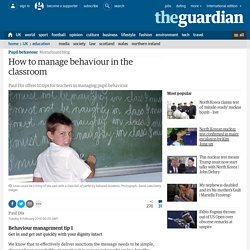

Know what your students need and want. Classroom Management. How to manage behaviour in the classroom. Behaviour management tip 1 Get in and get out quickly with your dignity intact We know that to effectively deliver sanctions the message needs to be simple, clear and non-negotiable; in practice it is easy to get caught up in a lengthy argument or confrontation.

Focus on moving in, delivering your sanction as discreetly as possible and then moving out quickly. Managing Today's Classroom. The Butterfly Effect: Behaviour Management. Anyone who knows me will be aware of my penchant for Monster energy drinks (there are other brands available).

At the start of my 50 minute drive to work in the morning, I tend to ‘crack’ open the can in the hope that I will have slowly consumed the 500ml of chemical infused liquid by the time I arrive at work, where I will be all set for the day ahead. One morning last week, I made a small (bad) decision at the start of my journey that had a knock on effect for the rest. So the bad decision I made? Well, rather than rid the cup holders in my car of the empty cans of past drives, I decided to leave them be. Behaviour Management. Engaging Without Carrots & Sticks. CC Image from Dr.

How to Motivate Learning: Alternatives to Rewards. One of the first and most important rules of behavior management is that when you take something away, you need to give something back.

It's not good enough to say, "Don't" without saying, "Do this instead. " Alternatives must be provided for change to occur. In my last post (Why Giving Bonus Money to Better Teachers Is Wrong), I strongly rejected the use of rewards, incentives, bribes and other harmful gimmicks. Now it is my responsibility to offer viable alternatives so that educators have the ability to change. These alternatives are plentiful. 1) Show Appreciation I once did a training session in San Francisco on alternatives to reward with Alfie Kohn and William Glasser, two men whom I respect and mostly agree with. The difference between manipulation and appreciation is that the first has an ultimate pre-determined destination, while the second is an expression of genuine feelings. 2) Introduce Appropriate Challenge People rarely chose the second. Praise: The good, the bad and the ugly. “Feelings of worth can flourish only in an atmosphere where individual differences are appreciated, mistakes are tolerated, communication is open and the rules are flexible” Virginia Satir Sanctions and praise have always gone hand in hand.

The old adage of ‘carrot and stick’ rings true for many. It would be easy to think that in terms of managing children in a school, they would want to avoid the sanctions and punishment and work tirelessly for the praise. For the masses this may be gospel truth but there are some children who end up getting sanctioned when they do something wrong and then what feels like a sanction again when they are praised for doing something right. 99 Ways to Say "Very Good" Classroom Rewards Reap Dividends for Teachers and Students. All teachers prefer to rely on their students' intrinsic motivation to encourage them to come to school, do their homework, and focus on classroom activities, but many supplement the internal drive to succeed with external rewards.

The teachers say rewards -- free time, school supplies, or tasty treats -- can help kids master the expectations of acceptable classroom behavior and scholastic achievement. Included: Ten tips for using rewards in the classroom! Icebreakers. Back to school Part 2: Relationships. This series of #backtoschool blogs summarises much of my thinking as it’s developed over the past few years and is aimed at new or recently qualified teachers.

Each area has been distilled to 5 ‘top tips’ which I hope prove useful to anyone embarking on a career in teaching. That said, I’ll be delighted if they serve as handy reminders for colleagues somewhat longer in the tooth. Once clear and sensible routines are in place, there’s space for positive relationships to form; without them, we are merely fire-fighting. Somewhat surprisingly perhaps, pupils prefer teachers they perceive as ‘stricter’ and want the reassurance of feeling safe, and knowing exactly where they stand. Classroom Culture. Classroom Management. Golden Rules for Engaging Students in Learning Activities. When we think of student engagement in learning activities, it is often convenient to understand engagement with an activity as being represented by good behavior (i.e. behavioral engagement), positive feelings (i.e. emotional engagement), and, above all, student thinking (i.e. cognitive engagement) (Fredricks, 2014).

This is because students may be behaviorally and/or emotionally invested in a given activity without actually exerting the necessary mental effort to understand and master the knowledge, craft, or skill that the activity promotes. In light of this, research suggests that considering the following interrelated elements when designing and implementing learning activities may help increase student engagement behaviorally, emotionally, and cognitively, thereby positively affecting student learning and achievement. 1. Make It Meaningful In aiming for full engagement, it is essential that students perceive activities as being meaningful. 2. 3. 4. 5. 6. Research Ames, C. (1992). Teacher resources. Classroom and behaviour management. Classroom & behaviour management. Classroom/Behaviour Management.